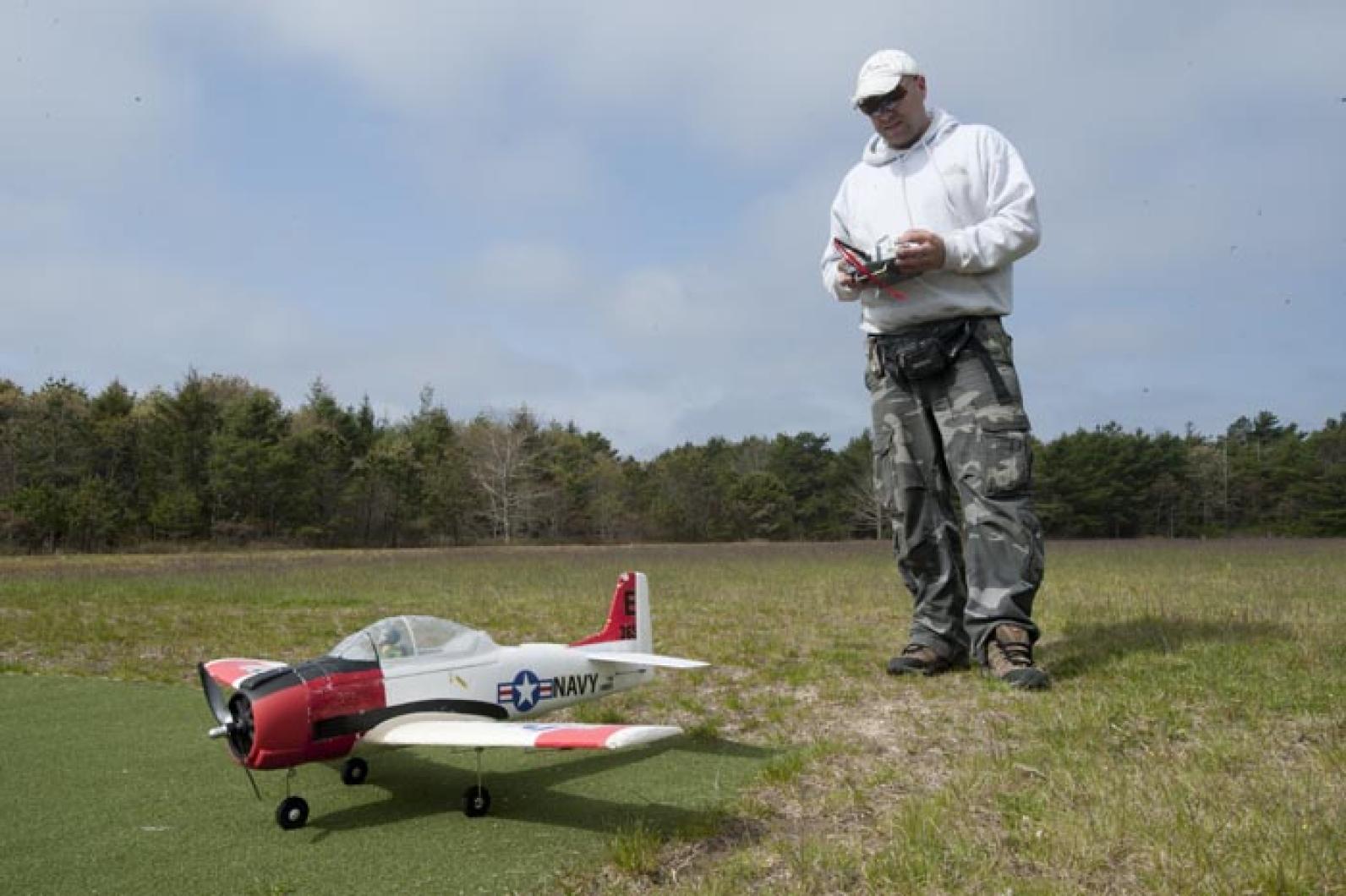Flight continues to attract enthusiasts of all ages. With advances in technology it is easier and cheaper than ever to build and fly a small model airplane. Recently, one Saturday morning a group of 20 gathered in the otherwise empty regional high school gymnasium. These members of the Martha’s Vineyard Model Flying Club flew their planes, some with wing spans of no more than 20 inches, in small circles in the large, high-ceilinged room against a backdrop of high school basketball banners hanging on the wall.
A tiny helicopter hovered almost motionless aloft, like a bumble bee hovering over a flower. The gym was a perfect spot for this flight school. No wind, few distractions and the temperature inside a lot warmer than outside, especially in winter.
Each flier held a black and silver radio-control transmitter. The controller antennas looked like short fishing rods. The pilots, with their feet on the ground, kept close touch with their airplanes by turning a small swivel with their thumb and forefinger. Eyes were aloft. Eleven-year-old Evan Sauter of West Tisbury stood next to Carl Watt, 74, of Edgartown. The two were firmly concentrated on their craft.
Later, after Mr. Watt’s plane landed, he talked about the hobby as a wonderful way to link generations, the young and old. It is not just flying, it is assembling parts together to make a craft that flies and then flying it.
Mr. Watt started assembling model airplanes when he was seven years old. His interest in flying never waned. He has had a number of careers before retiring as an attorney, including aeronautical engineering.
Bill Richard of Vineyard Haven, the club’s president and safety officer, stood at attention watching the planes. His role on this day was as spotter. Club safety rules require that there always be someone focused on safety.
“The hobby is growing on the Vineyard,” Mr. Richard said. There are now twice the number of members (34) in the club compared to five years ago. “When I started playing with model airplanes 10 years ago, I couldn’t find anyone interested on the Vineyard. I checked with hobby shops here and on the mainland. Nobody knew of anyone on the Vineyard flying model airplanes. Finally, I saw a flyer, a piece of paper on the wall, in the plumbing section of Hinckley’s Lumber yard on Beach Road. I went to their next meeting.”
He soon discovered a network of men of all ages, like himself, deeply involved in assembling aircraft of different sizes.
Joe Costa, 80, of Vineyard Haven is one of the Island’s senior fliers. For 45 years he worked at the Steamship Authority and retired 15 years ago as a purser. “I’ve been building model airplanes since I was seven,” he said.
Mr. Costa has over 34 small airplanes and five helicopters in a basement room measuring 12 by 40 feet. He has three large planes in his garage, hanging from the roof rafters. Mr. Costa has as many model airplanes as the Vineyard airport at times sees on its runway. Mr. Costa is also a highly-qualified pilot, though in the last two years he has been mostly piloting airplanes with his feet on the ground.
“So much has changed in the way planes get built,” said Mr. Costa. In the early years of flying, fliers used gasoline-powered motors to get their airplanes aloft. “Gasoline is messy,” he said. In the last 20 years, model makers have shifted to safer electric-powered motors. Mr. Costa said the technology in batteries has made huge advances. Batteries are so much lighter and more powerful now. Model airplanes are now also lighter and fairly affordable.
Enthusiasm for the sport increased three years ago when the club got permission to use the regional school gymnasium in the winter on Saturday mornings. The planes fly around like bees far from the hive. “We attracted a lot of kids,” Mr. Richard said. The gym is perfect for flying. There is ample space to keep the planes from mid-air collisions.
The club also got the go-ahead to clean up a portion of the Manuel F. Correllus State Forest near the high school’s athletic field for a small runway and flying area. The field has become a green park with benches for pilots and spectators. Through the efforts of volunteers, the site is maintained and is popular among all the fliers.
There are worries about the future of the hobby nationwide. Mr. Richard said he and others are concerned about possible government intervention in the sport. Mr. Richard said club members worry their innocent use of remote controlled aircraft might be perceived by the government as potentially harmful.
“I think they are afraid we will fly our planes into hotels, buildings or boats, ” Mr. Costa said. “We hope that the FAA doesn’t do away with these model airplanes.”
On Wednesday, Arlene Salac, a spokesman for the FAA in Burlington, said the FAA is working on new guidelines on the use and marketing of remote-controlled aircraft. She said it is not so much a worry about their being used for harmful purposes, though that is a concern, but that they are increasingly more popular.
Club members are already following regulations that have been set up by the Academy of Model Aeronautics (AMA). The club regulations together with those by the AMA call for the use of a safety spotter, restrictions on what can be in an airplane, height off the ground, where they can go, and how they are powered.
Mr. Richard said the club welcomes anyone who is interested in model airplane flying to come to their regularly-scheduled flight exercises at their flying field, adjacent to the new baseball diamond near the high school. They usually meet on good weather days, Thursday afternoons at 4 p.m. until dark, and Saturdays from 9 a.m. “until we get tired,” Mr. Richard said.
For more information, Mr. Richard can be reached at 508-693-9381.




Comments
Comment policy »